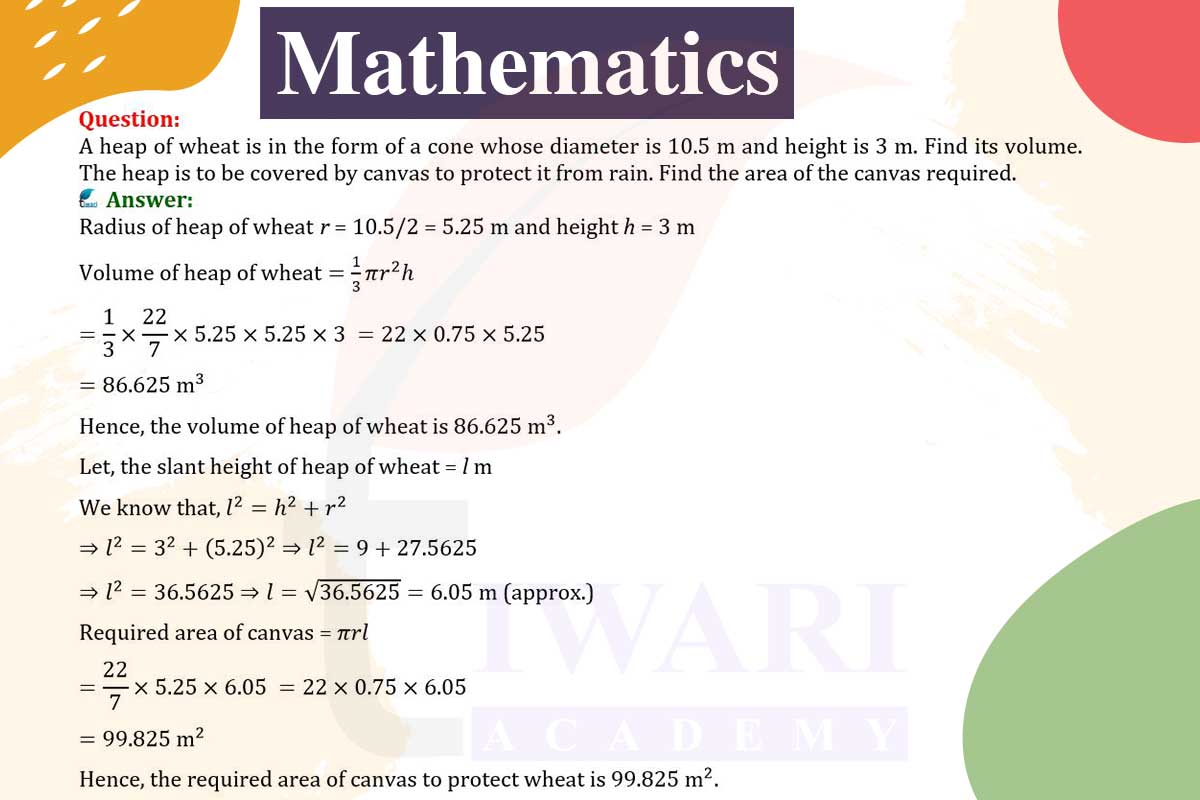To find the volume of a wheat heap in the shape of a cone with a diameter of 10.5 m and a height of 3 m, use the formula V = (1/3)πr²h. The radius r is half the diameter, so r = 5.25 m. Substituting h = 3 m into the formula, calculate the volume.
For the canvas area, calculate the slant height l using Pythagoras’ theorem, l = √[r² + h²], and then find the lateral surface area (canvas area) using LSA = πrl. This gives the area of the canvas needed to cover the heap.

Let’s discuss in detail
Geometric Application in Practical Problems
The calculation of the volume and surface area of a conical heap of wheat represents a practical application of geometric principles. This problem not only demonstrates the relevance of geometry in everyday life but also showcases how mathematical formulas can be used to solve real-world problems. In agriculture, for instance, understanding the volume of a grain heap is crucial for storage and distribution, while calculating the surface area is essential for determining the amount of material needed for covering and protecting the heap.
Understanding the Geometry of a Cone
A cone is a three-dimensional shape with a circular base that narrows smoothly to a point, known as the apex. The key dimensions of a cone are its radius, height, and slant height. The radius is half the diameter of the base, the height is the perpendicular distance from the base to the apex, and the slant height is the length of the line segment from the apex to the edge of the base. These dimensions are crucial for calculating both the volume and the surface area of the cone.
Calculating the Volume of the Wheat Heap
The volume of a cone is given by the formula V = (1/3)πr²h, where V is the volume, r is the radius, and h is the height. For a wheat heap with a diameter of 10.5 meters, the radius r is half of this, which is 5.25 meters. The height h of the heap is 3 meters. Substituting these values into the formula, we calculate the volume of the wheat heap. This volume is a measure of the capacity of the heap.
Determining the Slant Height for Canvas Cover
To cover the heap with a canvas, we need to calculate the slant height of the cone. The slant height l can be found using Pythagoras’ theorem, l = √[r² + h²]. With the radius r = 5.25 meters and height h = 3 meters, the slant height is calculated. This slant height is essential for determining the area of the canvas required to cover the heap completely.
Calculating the Area of the Canvas
The area of the canvas required to cover the heap is essentially the lateral surface area (LSA) of the cone. The LSA of a cone is calculated using the formula LSA = πrl, where r is the radius and l is the slant height. After finding the slant height, these values are substituted into the formula to determine the area of the canvas needed to cover the wheat heap.
Implications of Geometric Calculations
In conclusion, the calculation of the volume and the surface area of a conical wheat heap demonstrates the practical application of geometric formulas. This problem-solving approach is not only essential in academic settings but also has significant real-world implications, particularly in fields like agriculture and storage management. Understanding these concepts allows for efficient planning and resource management, highlighting the importance of geometry in practical scenarios.
Discuss this question in detail or visit to Class 9 Maths Chapter 11 for all questions.
Questions of 9th Maths Exercise 11.3 in Detail

